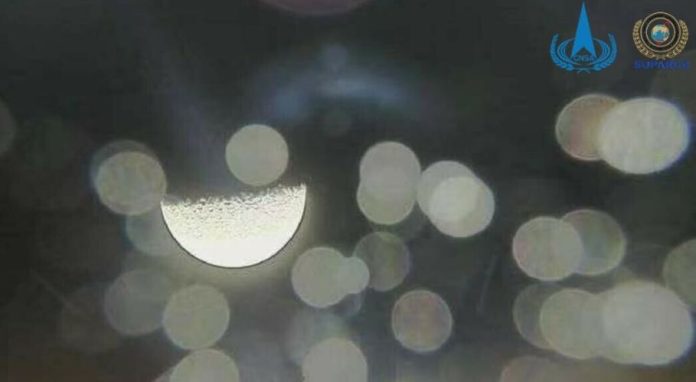ISLAMABAD, MAY 10: Pakistan’s inaugural lunar satellite iCube-Qamar on Friday transmitted the first-ever images captured by it from the lunar orbit, the national space agency said.
The satellite, part of China’s Chang’e-6 lunar mission, was launched from the Hainan province on May 3 and had successfully entered the moon’s orbit at 1:14pm on May 8. The moon is at an average distance of 384,400km from earth.
The lunar module was designed by Islamabad’s Institute of Space Technology (IST) in collaboration with China’s Shanghai University (SJTU) and Pakistan’s national space agency Suparco.
The landmark images were unveiled at a ceremony organised at the China National Space Agency (CNSA) to mark the successful mission accomplishment, Suparco spokesperson Maria Tariq told Dawn.com.
They were officially handed over to Pakistan’s ambassador to Beijing, she added.
One of the first-ever images captured by Pakistan’s inaugural lunar satellite iCube-Qamar shows the moon and the sun. — Suparco/CNSA
The iCube-Q orbiter carries two optical cameras to image the lunar surface. The module is a cube satellite or cubesat — miniature satellites typically characterised by their small size and standardized cubic design.
Due to their compact size and relatively low cost compared to traditional satellites, CubeSats offered opportunities for universities, research institutions and commercial entities to participate in space missions and gather valuable data for scientific advancement and innovation.
Operating in extreme temperatures as low as minus 100 degrees Celsius, the satellite features a 7-kilogramme one-megapixel camera tailored for missions with power constraints.
Dr Khurram Khursheed, head of Department of Electrical and Computer Science at the IST, had said the satellite would play a critical role in deep space missions.
“Its surface-level analysis capabilities, transmitting images at a modest 1-kbps, will provide crucial data on crater locations, water, and traces of ice on the moon’s surface,” he had said.
As the Chinese lander collects rock and soil samples, iCube-Q will spend three to six months orbiting the moon, capturing and transmitting images of the moon back to Earth.
The IST said the opportunity to release the cubesat in lunar orbit from the Chang’e-6 mission was offered by the CNSA through the Asia Pacific Space Cooperation Organisation (Apsco). After a thorough evaluation, Pakistan’s proposal was accepted out of all Apsco member states.
One of the first-ever images captured by Pakistan’s inaugural lunar satellite iCube-Qamar shows the sun shining brightly. — Suparco/CNSA
Chang’e-6 mission
The Chang’e-6 mission, which aims to explore the moon’s “dark side”, employs lunar research payloads from multiple countries, including Pakistan’s iCube-Qamar satellite.
The mission is named after the mythical Chinese moon goddess. Nasa is banned by US law from any collaboration, direct or indirect, with China.
On Chang’e-6, China is carrying payloads from France, Italy, Sweden and Pakistan, while Chang’e-7 will bear payloads from Russia, Switzerland and Thailand when it launches in 2026.
Chang’e-6 aims to collect around 2kg of lunar samples from the far side of the Moon and bring them back to Earth for analysis. Chinese state news agency Xinhua had hailed it as “the first endeavour of its kind in the history of human lunar exploration”.
China will send a robotic spacecraft in the coming days on a round trip to the moon’s far side in the first of three technically demanding missions that will pave the way for an inaugural Chinese crewed landing and a base on the lunar south pole.
The probe is set to land in the immense South Pole-Aitken Basin, one of the largest known impact craters in the solar system. Once there, it will scoop up lunar soil and rocks, and carry out other experiments in the landing zone.
With no direct line of sight with the Earth, Chang’e-6 must rely on a recently deployed relay satellite orbiting the moon during its 53-day mission, including a never-before-attempted ascent from the moon’s “hidden” side on its return journey home.

















